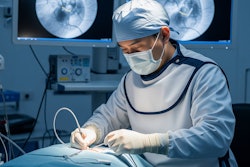In Southwest Germany, just around the corner from the state capital Stuttgart, lies the beautiful city of Tübingen. Here you will find one of Germany's largest healthcare providers, the University Hospital of Tübingen. Founded in 1805, it is the city's largest employer with more than 11,000 employees and nearly 500,000 patients per year.
In addition, the city is home to Cyber Valley, Europe's largest and leading center of excellence for AI and modern robotics. This means that the hospital has state-of-the-art surgical robots at its disposal, and it is no surprise that the university hospital is the first medical facility in the world to provide its employees and patients with a fully automated cooking robot.
 Is this the future of catering in healthcare? Courtesy of MarioAndreya/Sodexo.
Is this the future of catering in healthcare? Courtesy of MarioAndreya/Sodexo.
Although the hospital has several cafeterias and canteens for its employees, patients, and guests, there were few options for eating a balanced diet outside of normal opening hours. Employees working night shifts in particular had to bring their own food or buy snacks from vending machines.
Since May 2024, the robot kitchen from the startup company goodBytz has provided healthy meals for employees and visitors around the clock. The university hospital and the large-scale caterer Sodexo, which operates the six cafeterias on the hospital grounds, are thus expanding their gastronomic offerings.
“Now it is possible to get fresh, healthy, and hot meals even outside the opening hours of the canteens and cafeterias. This is particularly interesting for our employees who work shifts and weekends,” says Dr. Tobias Anton Schneider, head of operations and logistics at the University Hospital. The hospital spent around €70,000 on the setup and conversion costs for installing the machine. The large-scale caterer Sodexo leases the robot kitchen on a monthly basis for a low four-figure sum.
But can the cooking robot really compete with freshly prepared meals? And how much of an asset is it for employees?
 It sure beats fast food! Dr. Saif Afat gives the thumbs up to the initiative.
It sure beats fast food! Dr. Saif Afat gives the thumbs up to the initiative.
Dr. Saif Afat, managing senior physician from the Department of Diagnostic and Interventional Radiology in Tübingen, has a clear opinion: “I am a big fan since day one of the robot chef! The preparation time is relatively short, and the taste is also impressive!”
The robot can serve up to 150 dishes per hour and offers a variety of five dishes -- from Italian to French or even Thai cuisine, with at least one vegetarian option daily.
“The biggest benefit is clearly the accessibility outside of the normal opening hours of our canteens or cafeterias,” Afat continued. “In the past, we had to order pizza or other fast food during the late shift, and now we have our own robot chef cook for us!”
 The scheme's a neat example of how digitization and thoughtful design can bring positive change, Dr. Mathias Goyen comments.
The scheme's a neat example of how digitization and thoughtful design can bring positive change, Dr. Mathias Goyen comments.
Hospital visitors are also encouraged to try out the cooking robot. In July 2025, radiologist Prof. Dr. Mathias Goyen, chief medical officer for Imaging & AVS at GE HealthCare, visited Tübingen on a business trip about lung cancer prevention, and he was impressed by the machine. “It’s a great example of how digitization and thoughtful design can enhance everyday experiences in healthcare -- for patients, staff, and even guests,” he said.
However, the new robot cannot do without human help entirely. A service employee fills the refrigerator in the robot kitchen with fresh ingredients every morning. Once customers have selected a dish via a display and paid by card, the robot’s arms spring into action. One of the arms retrieves the ingredients from the refrigerator, mixes them in a pot, and places the contents on one of eight hotplates. A second arm takes care of serving, while a third arm handles the washing up.
 The robot can serve up to 150 dishes per hour. Courtesy of University Hospital of Tübingen
The robot can serve up to 150 dishes per hour. Courtesy of University Hospital of Tübingen
Hopefully, the concept will catch on and the next-generation hospital food will be enjoyed across Europe and beyond.
Steven Patrick Pohl is a public relations officer at the University Hospital of Tübingen, Germany.
The opinions expressed in this review are those of the author and do not necessarily reflect the views of AuntMinnieEurope.com.



















